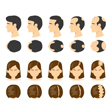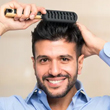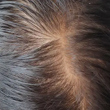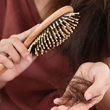Can a Scalp Massage Help Your Hair Grow?
We've all had our scalp massaged at one time or the other, whether in a salon or the good old champi from our grandmothers. Without any doubt, it's one of the most relaxing experiences we've had.
Scalp massages are known to relieve stress and tension. However, the efficacy of scalp massages is not just restricted to helping you de-stress. They are also known to promote hair growth.
Though there is limited research on this topic, some studies lean towards the theory that scalp massages can aid hair growth. Read on to find out more.

Does Scalp Massage Boost Hair Growth? 1,2
A small study of nine men conducted in 2016 concluded that scalp massages might lead to thicker hair. These nine men were given a 4-minute massage every day for 24 weeks. At the end of the period, it was found that these men had thicker hair than before.
Another similar study conducted in 2019 found that the symptoms of hair loss improved from regular massage. This study was conducted among 340 participants who massaged their scalp twice daily. Approximately 69% of the participants showed signs of improvement.
The possible reason behind this could be the increase in blood circulation to the scalp and hair follicles. Scalp massage stimulates blood to the hair follicles by dilating the blood vessels under the skin. This stretches out the cells of the hair follicles leading to the production of thicker hair strands.
How to Massage Your Scalp for Hair Growth?
There are many ways you can massage your scalp for hair growth Below are some options:
Traditional Massage Using Your Fingertips

In this traditional method, you use your fingertips to stimulate blood flow in the scalp.
- Slide the fingertips of both your hands under your hair and onto your scalp.
- Use the ball of your fingertips to apply light to medium pressure.
- Use small circular motions to gently move around your entire scalp. The small circles focus your energies on one section at a time and bring blood to the area.
- Using your thumb, you can also gently pull the skin of your scalp up.
- Try this method for at least five minutes, twice a day.
You can also have someone else do this for you for a more relaxing experience. Better still, visit a licensed therapist if you have the time and money for it.
Massage During Hair Wash

If you have a busy schedule, you can utilize your time in the shower to gently massage your scalp for a few minutes. You'll find that it's much easier to glide your fingers around your scalp when it's wet. Massage the shampoo or conditioner into your hair for 3 to 5 minutes. Then rinse off as usual.
Just remember to be extra gentle while massaging wet hair since your hair is more fragile and prone to breakage when wet.
Massage Using Scalp Massagers

Various tools are available in the market nowadays that will aid you in effectively massaging your scalp. These include electric brushes and scalp massagers for hair growth. Massagers work to stimulate and exfoliate the scalp helping you get rid of dry or flaky skin, product buildup, and excess oil.
While there is no evidence that massagers work better than fingertips, some dermatologists recommend them for a more effective massage. You can find massagers suitable to be used for both dry and wet hair as per your preference. Just make sure to go for the one with soft bristles.
Massage with Essential Oils 3, 4

Most Indians use hair oil while massaging their scalp. Try adding a few drops of essential oil to your regular oil before massaging. Certain studies have shown that essential oils such as lavender and peppermint can aid in hair growth.
Lavender is known for its antifungal properties. They can help reduce instances of dandruff and product buildup. It is also one of the few essential oils containing a natural compound called Linalyl Acetate. Linalyl Acetate is known to be effective for the growth of cells and reproduction of skin.
Oil massage is best for people with dry hair since they stimulate natural oil production in the scalp. Warm your oil and gently apply it to your scalp in a circular motion. Leave it for half an hour, and then wash it off with shampoo.
Before applying any essential oil, do ensure that you're not allergic to it. You can do this by conducting a patch test on a small area first, such as your elbow or your wrist.
In Conclusion
Massaging your scalp could be the most natural way to relieve stress and, at the same time, increase the thickness of your hair. Combine it with a healthy diet and regular hair care routine to improve your hair health.
Myth Busters HairFall

Androgenetic Alopecia - Everything You Need To Know
Have you been experiencing excessive hair fall over a prolonged period of time? It could be an early sign of androgenetic alopecia. It is a hair loss disorder common in both genders and can lead to progressive thinning and even baldness in some patients if not caught and treated early.

How To Make Hair Grow Faster For Men
A head full of healthy hair is a matter of confidence. Hair has its own mechanism of growing and shedding, and it is when this mechanism is thrown off that growth is hindered. Especially in the case of males, hair growth faces a lot of hiccups that can easily be managed.

Female Pattern Baldness - Causes & Treatments
Have you suddenly noticed an increase in the number of hair strands on your pillow in the morning? Or is your ponytail getting thinner by day? Well, you might be suffering from female pattern baldness. While that does sound scary, identifying it early on is key to treating this condition effectively. So keep reading to know what this is, how you can identify it, and most importantly, what treatments you can avail of to get your beautiful lustrous hair back.

What Are The Reasons For Hairfall?
Almost everyone experiences some amount of hair thinning over the years. Shedding around 50 to 100 single strands of hair per day is considered normal. However, losing more than 150 strands a day, experiencing sudden thinning, or developing circular bald patches on your scalp are reasons for concern. Hair loss occurs when new hair doesn’t grow fast enough to replace the amount of hair you lose daily. Hair can fall due to various reasons, with hereditary hair loss and poor nutrition being the most common hair fall reasons.

Expert Approved Tips For Hair Growth
What can be more debilitating than seeing hundreds of hair strands shedding from your scalp every time you brush your hair? Also, excessive molting occurs during seasonal changes that can be very stressful for you. Although it’s okay to lose between 50-100 strands every day, according to the American Academy of Dermatology, the problem occurs when you start shedding more than normal. But that doesn’t mean you have to feel helpless as there are ways to grow your hair back. Even if you are coping with baldness or alopecia, certain hair growth tips from dermatologists can come to your rescue. Read on to discover how these tips can be your savior when abnormal hair fall problems are in sight.
Trending Videos
+ 4 Sources
'LMRC - GGI-CO-A2-DMA-300001252-300001252-WM-L21-704'
© 2021 Dr. Reddy’s Laboratories Ltd. All rights reserved.